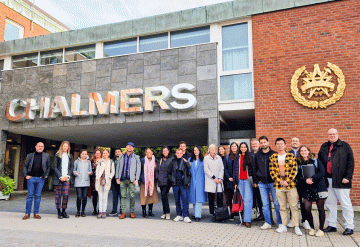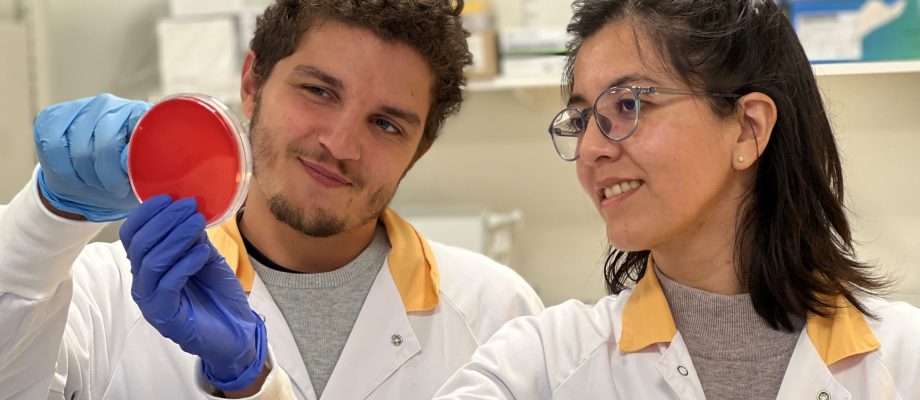DOCTORAL STUDIES. A faster, easier, and cheaper way for healthcare providers to determine the pathogen that caused an infection and ultimately to find new types of antibiotics. These are some of the objectives of a European Union project involving a total of 15 doctoral students. The project also focuses on student mobility and student exchanges.
Two of the doctoral students in the program are currently at the Department of infectious diseases in Gothenburg. Leonarda Achá Alarcón, originally from Bolivia, is pursuing her doctoral studies at the University of Gothenburg. Her colleague, José Laco, originally from Portugal, is a doctoral student at the University of Balearic Islands in Majorca, Spain.

The project is called PEST-BIN (Pioneering Strategies Against Bacterial Infections). It aims to improve diagnostics for infectious diseases and to better understand and combat antibiotic resistance. A total of 15 doctoral students are participating in the project, which includes universities, hospitals, and private companies among its partners. The project is part of the EU program Marie Skłodowska-Curie Innovative Training Network (MSCA ITN) within Horizon 2020.
Visiting each other
The exchange among the universities, hospitals, and companies involved in the project is also an important goal of this doctoral program. For that reason, José Laco is now visiting Leonarda’s team in Gothenburg for a few months.

“I have just arrived. It will be exciting to see what comes out of the visit. I hope to learn a lot, especially about proteomics.” José is working on the part of the project that will increase our knowledge of infection mechanisms, hoping this will eventually lead to new antibiotics.
“It is part of the effort to tackle antibiotic resistance, a growing problem in many countries. In my project I identify bacteria that cause infections and the antibiotic resistance genes these bacteria have.”
New sensor made of graphene
The project aims to develop new technologies to fight bacterial infections, and researchers are pursuing four different lines of research to achieve this goal. The methods include nanotechnology, proteomics-based diagnostics, and big data analysis with artificial intelligence (AI).
Several doctoral students with PEST-BIN also work at Chalmers University of Technology, within the flagship of the super-material graphene. In the case of bacterial infections, highly sensitive graphene sensors are being developed to provide a quick answer to the type of bacteria involved immediately after sampling. This enables physicians treating the infection to apply the right antibiotics from the outset. Now bacterial samples often must be cultured, sometimes for several days, before receiving an answer. The broad-spectrum antibiotics that might be used before the exact bacterium is known pose a risk of increasing antibiotic resistance in various strains of bacteria.
Immediate test results
The goal is to allow healthcare professionals to take a bacterial sample straight from the patient, apply it to a graphene sensor, and immediately get a clinically relevant result. But to do that, the sensor needs to know what to detect. That is where Leonarda’s part of the project comes in.
Using methods based on mass spectrometry and proteomics, she works on identifying biomarkers on the bacterial surface that can be detected by the sensor being developed.

“Our team has already identified peptide biomarkers for several pathogens, and we have shown that we can identify the right strains directly from patient samples collected with a nasal swab. We have several years left in the project to show how the biomarkers can be used in the clinic with a simple test kit or sensor made of graphene,” says Leonarda.
Biomarkers on the surface of bacteria
New biomarkers can save time in the clinic and reduce the use of antibiotics.
“Viruses often cause respiratory infections, but pneumonia can also be caused by bacteria. It can take days to determine the cause, and many patients–especially in other countries–receive antibiotics just in case, often unnecessarily,” says Leonarda. She was recently named as one of the recipients of this year’s Bollan scholarship, which will fund access to the Proteomics Core Facility.

Her supervisor is Roger Karlsson, a chemist at Sahlgrenska University Hospital and an associate professor at the University of Gothenburg. He is one of the inventors of a method that enables “shaving” bacteria so that the proteins analyzed come from the surface of bacteria and not from the cytoplasm inside them.
BY: ELIN LINDSTRÖM











